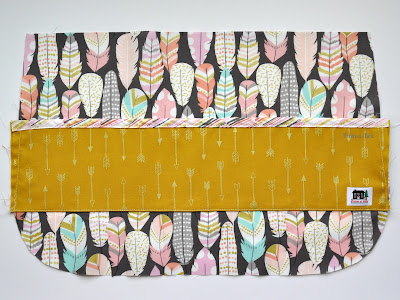The E+M Top Pattern No. 26 makes a nice casual knit shirt or dress for girls. With options for short, 1/2, or long sleeves in a raglan style, and straight hemmed or high-low shirt, or dress length, this pattern fits all seasons. And it fits your girls sizes 2 to 10.
For this PATTERN REVIEW, I made a short sleeve, high-low top for my 6 1/2 year old girl.
The shirt fabric is from the online shop Whimsical Fabric. It is Greeka in Skoura knit fabric from the Skopelos Art Gallery Collection for the short sleeves and lower front and back, and matched with a Strawberry Kiss knit fabric by Art Gallery for the upper front and back.
The E+M Top Pattern No. 26 is a PDF pattern that is professionally written, easy to follow, includes multiple sewing options, and is suitable for a beginner seamstress with experience sewing knit fabrics.
Printing & Assembling the Pattern…
The pattern includes clear printing and assembling directions. The pages to print for each of the look variations is listed for easy reference - so ink and paper are not wasted. The pattern does not have layers, meaning that you can’t select to print only the size desired. Based on the pattern design, it isn't a ink and paper waste to print all sizes, but it does require attention to cut the on the correct lines. The lines do not cross on the pattern, so this is simple enough.
The instructions are clear with explanation of each sewing step. The pattern includes different tips & tricks for the sleeve hems, different options for finishing the seams and neck band, and optional serger sewing instructions. The instructions are not too wordy, and not too brief. They are consistent and organized efficiently. The pattern includes sizing and measurement charts, supplies list, and material needs - I found these to be accurate in my pattern use.
This pattern is appropriate for a beginner seamstress that has sewn knit garments before or that is ready to go further with knit patterns. The instructions include detailed Sewing With Knits information for regular sewing machine. And there are so many tutorials and videos to provide more information about knits, that I think this pattern is suitable for beginners that have some sewing garments experience.
My favorite feature of this pattern is the pictures. Generally, I prefer line drawings in my PDF Patterns because I want to clearly see the sewing instructions and be able to distinguish the pattern pieces without the distraction of a fabric print or color. Then I want close-up pictures of an actual item to see the results of a sewing step. (forgive me if this is overly specific, but this is what I like best in my PDF Patterns) Well, in this E+M Pattern, there are pictures of the actual garment, but she used a gray fabric photographed on a white background, and then annotated the photograph with dashed lines and arrows. GENIUS.
Here is an example:
So now, the pictures simply show me both the instructions and the results. Again, GENIUS.
My girl is between a size 6 and size 7, so of course I sized up, and the top fits well. I am happy with the fit. I like that the shape of the top gently curves in at the waist. The length is long enough to cover my tall girl.
With the finished seams and top-stitching, gathers at the bodice, clean neckline, and high-low length, the completed shirt is a WINNER. I expect this one to be seen often on my girl.
The pattern is available on Whimsical Fabric HERE. And check out all the knit fabrics too!To see more creations from Stacey, visit her blog at From-a-Box.
Happy Creating!
Danielle Storm
www.whimsicalfabric.com






























































